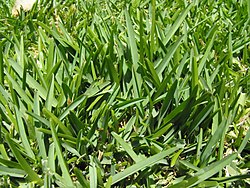Stenotaphrum secundatum
| Habit | grass
| |
|---|---|---|
| Height: | ⇕ | 2 in"in" can not be assigned to a declared number type with value 2. to 16 in"in" can not be assigned to a declared number type with value 16. |
| Width: | ⇔ | 2 in"in" can not be assigned to a declared number type with value 2. to 16 in"in" can not be assigned to a declared number type with value 16. |
| Lifespan: | ⌛ | perennial |
| Exposure: | ☼ | sun |
|---|---|---|
| Water: | ◍ | moderate |
| Features: | ✓ | evergreen |
| USDA Zones: | 9 to 11 |
|
Poaceae > |
St. Augustine grass (Stenotaphrum secundatum) (also known as Charleston Grass in South Carolina) is a warm season lawn grass that is popular for use in tropical and subtropical regions. It is a low to medium maintenance grass that forms a thick, carpetlike lawn, crowding out most weeds and other grasses.
St. Augustine is a dark green grass with broad, flat blades. It spreads by above ground stolons and forms a dense layer of grass.
St. Augustine is one of the most shade tolerant warm season grasses, thriving beneath partial shade of large trees, shrubs, and structures.
St. Augustine grass is one type of grass that commonly exists in most Caribbean and Mediterranean areas. It breeds best in tropical climates. It is often seen in lagoons, marshes, shorelines and wherever there is a good amount of moisture.
It is native to both sides of the Atlantic ocean,[1] including much of the southeastern United States,[2][3] Mexico,[1] and Central and South America.[1] It has escaped cultivation in California,[4] many Pacific islands,[1] and New Zealand.[1]
St. Augustine can grow in a wide range of soil types with 5.0 to 8.5 pH. St. Augustine grasses will be in full bloom between springtime and summer.
St. Augustine grasses are popularly used in pastures and ranches. They are also a popular grass covers for home lawns. It rivals the reputation of Bermuda grass, although St. Augustine grasses are somewhat less drought tolerant.
Cultivation
Propagation
St Augustine grass produces runners that allow it to grow and spread.
Only recently has commercially valuable viable seed for St. Augustine become available, so it has typically been propagated by plugs, sprigs, or sod. Once the grasses are cultivated, then they can propagate on their own.
Pests and diseases
Varieties
St. Augustine comes in several varieties:
- Captiva(R). Released in 2008. Developed by the University of Florida for its Chinch bug resistance and dwarf profile which requires less mowing.
- Floratine. Released 1959. Darker color, finer texture, tolerated lower temperatures and lower mowing.
- Floratam. Released 1972. Resists SAD and chinch bugs. Not as cold- or shade-tolerant.
- Palmetto. Released in 1989. Selected for its shade tolerance and cold tolerance.
- Raleigh. Released 1980. SAD resistant and shade tolerant, but susceptible to chinch bugs.
- Sapphire. Released 2004. Selected from Australia for its dark blue green color and rapid lateral growth.
- Seville. Released 1980. Finer texture than Floratam, but shared Floratam's strengths and weaknesses.
- Texas Common. May be the original St. Augustine. It has fallen out of favor due to its susceptibility to the incurable St. Augustine Decline (SAD) virus.
- Variegatum. Has lvs. striped with white, and is used as a basket-plant.CH
Gallery
References
External links
- w:Stenotaphrum secundatum. Some of the material on this page may be from Wikipedia, under the Creative Commons license.
- Stenotaphrum secundatum QR Code (Size 50, 100, 200, 500)




